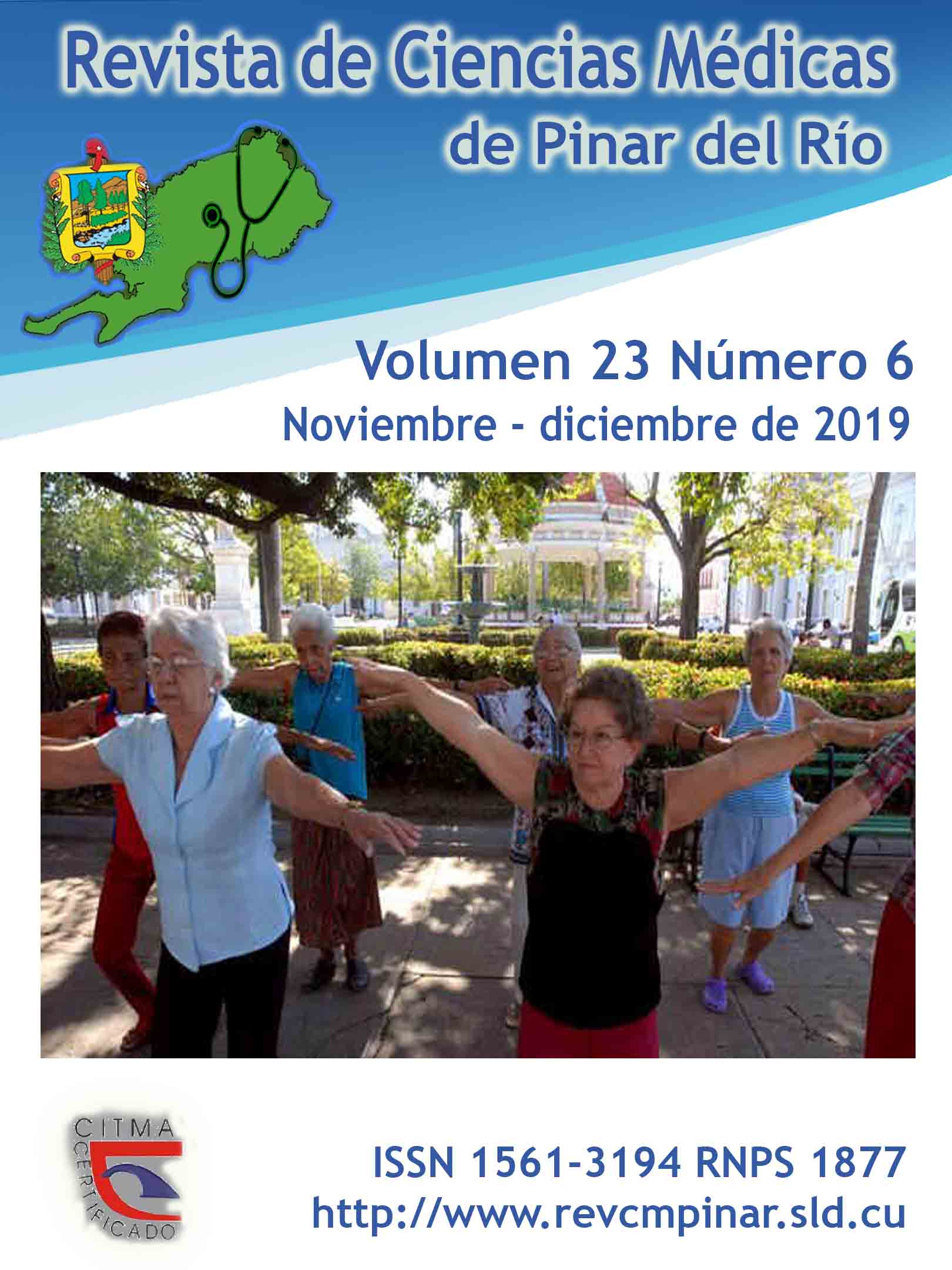Variations of the lower third of the face and temporomandibular disorders: needs of health care
Keywords:
VERTICAL DIMENSION, TEMPOROMANDIBULAR JOINT, TEMPOROMANDIBULAR JOINT DISORDERS, ORTHODONTICS/ treatment, DENTIST-PATIENT RELATIONS.Abstract
Introduction: temporomandibular joint is one of the most complex craniofacial structures; it maintains a close relationship with the neuromuscular, postural-tonic systems and the dental occlusion.
Objective: to identify the vertical dimensions of the lower third of the face and the temporomandibular disorders, to outline the needs of health care.
Methods: a descriptive, cross-sectional and observational study was conducted from January 2017 to February 2018 at Antonio Briones Montoto Teaching Dentistry Clinic. The target group was comprised of 803 students chosen from the Secondary School of the health area, while the sample included 256 schoolchildren. The clinical method was applied through a questionnaire and physical examination.
Results: of the students examined 14.8 % presented facial proportion, 33.9 % showed a decrease in the lower third and 51.1 % in the lower third increased, adolescents with temporomandibular disorders prevailed 52.3 % with the lower third of the increased face predominating the association with this disorder, 24.2 % of them presented Moyers Class I Syndrome and 18.3% Moyers Class II Syndrome related respectively to temporomandibular joint disorders, corrective treatment was most needed ( 47.4%).
Conclusions: the increased lower third was the greatest disorder determined presenting a statistically significant relationship with temporomandibular joint disorders regardless of gender, the Moyers class I syndrome was the most predominant and corrective orthodontic treatment showing the greatest need for health care.
Downloads
References
1. Shivakumar KM, Chandu GN, Shafiullac MD. Severity of Malocclusion and Orthodontic Treatment Needs among 12- to 15-Year-Old School Children of Davangere District, Karnataka, India. Eur J Dent [Internet]. 2010 Jul [Citado 12/09/2017]; 4(3): [aprox. 8p.]. Disponible en: http://preview.ncbi.nlm.nih.gov/pmc/articles/PMC2897864/?tool-pubmed
2. Meneses E, Vivares A, Martínez Restrepo LI. Trastornos temporomandibulares y factores asociados en adolescentes y jóvenes de la ciudad de Medellín. Revista Colombiana de Investigación en Odontología. [Internet] 2016 [Citado 01/10/2017]; 6(18): [aprox. 6p.]. Disponible en: https://www.researchgate.net/publication/325777213_TRASTORNOS_TEMPOROMANDIBULARES_Y_FACTORES_ASOCIADOS_EN_ADOLESCENTES_Y_JOVENES_DE_LA_CIUDAD_DE_MEDELLIN
3. Moyers R. Manual de ortodoncia para el estudiante y el odontólogo general. Buenos Aires: Editorial Mundi; 1992. p. 89-90.
4. Mayoral J, Mayoral G. Ortodoncia: principios fundamentales y práctica. 67ed. Barcelona: Editorial Labor; 1990. p.106-7.
5. Aguilar Moreno NA, Taboada Aranza O. Frecuencia de maloclusiones y su asociación con problemas de postura corporal en una población escolar del Estado de México. Bol Med Hosp Infant Mex. [Internet] 2013 [Citado 01/10/2017]; 70(5): [aprox. 7p.]. [aprox. 7p.]. Disponible en: http://www.scielo.org.mx/scielo.php?script=sci_arttext&pid=S1665-11462013000500005
6. Gregoret J. Ortodoncia y Cirugía Ortognática. Diagnóstico y Planificación. Madrid: Editorial ESPAXS; 1997. p. 17-21.
7. Cáceres Colli A. Prevalencia de signos y síntomas relacionados con la presencia de Trastornos Temporomandibulares en pacientes de edad infantil. [Internet]. Universidad Complutense de Madrid: Facultad de Odontología; 2014 [citado: 23/11/2017]. [aprox. 95p]. Disponible en: https://eprints.ucm.es/28451/
8. Fonseca Fernández Y. Factores epidemiológicos de la adaquia anterior en escolares de 5-12 años. Municipio Boyeros, curso 2013-2014. [Tesis doctoral]. La Habana: Universidad de Ciencias Médicas de la Habana. Facultad de Estomatología; 2014.
9. Caballero Gómez MC, Seguí Carmenates G, Hidalgo Pacheco A, Altunaga Carbonell A. Síndrome dolor disfunción temporomandibular en pacientes que han abandonado el tratamiento de Ortodoncia. AMC [Internet] 2014 [Citado 20/10/2017]; 18(6): [aprox. 11p.]. Disponible en: http://scielo.sld.cu/scielo.php?script=sci_arttext&pid=S1025-02552014000600004&lng=es
10. Llanes Serantes M, Suconota Abril L, Bravo Calderón M. Alteraciones verticales del tercio inferior de la cara y su relación con Trastorno Temporomandibulares en estudiantes de la ciudad de Cuenca. Revista Latinoamericana de Ortodoncia y Odontopediatría [Internet] 2014 [Citado: 20/10/2017]; 13(2): [aprox. 13p.]. Disponible en: https://www.ortodoncia.ws/publicaciones/2014/art-13/
11. Silva Contreras AM. Bruxismo: su comportamiento en un área de salud. Rev Ciencias Médicas [Internet]. 2015 Feb [Citado 25/09/2018]; 19(1): [aprox. 9p.]. Disponible en: http://scielo.sld.cu/scielo.php?script=sci_arttext&pid=S1561-31942015000100009
12. Murrieta J. Prevalencia de maloclusiones dentales en un grupo de adolescentes mexicanos y su relación con la edad y el género. Fund Act Odontol Venez. [Internet] 2007 [Citado 20/10/2017]; 45(1): [Aprox. 6p.]. Disponible en: http://www.actaodontologica.com/ediciones/2007/1/pdf/maloclusiones_dentales.pdf
13. Chávez González Z, Corona Carpio MH, Duque de Estrada Bertot ML, Duharte Escalante A. Principales afecciones dentomaxilofaciales en estudiantes de 12 años de la Escuela Secundaria Básica Urbana "Antonio Maceo Grajales". MEDISAN [Internet]. 2015 [Citado: 25/09/2018]; 19(4): [aprox. 7p.]. Disponible en: http://scielo.sld.cu/scielo.php?script=sci_arttext&pid=S1029-30192015000400005&lng=es
14. Eslamipour F, Borzabadi Farahani A, Asgari Y. Assessment of orthodontic treatment need in 11- to 20-year-old urban Iranian children using the Dental Aesthetic Index (DAI). World J Orthod [Internet] 2010[Citado: 7/02/2017]; 11(4): [Aprox. 8p.]. Disponible en: https://www.ncbi.nlm.nih.gov/pubmed/21490981
Published
How to Cite
Issue
Section
License
Authors who have publications with this journal agree to the following terms: Authors will retain their copyrights and grant the journal the right of first publication of their work, which will be publication of their work, which will be simultaneously subject to the Creative Commons Attribution License (CC-BY-NC 4.0) that allows third parties to share the work as long as its author and first publication in this journal are indicated.
Authors may adopt other non-exclusive license agreements for distribution of the published version of the work (e.g.: deposit it in an institutional telematic archive or publish it in a volume). Likewise, and according to the recommendations of the Medical Sciences Editorial (ECIMED), authors must declare in each article their contribution according to the CRediT taxonomy (contributor roles). This taxonomy includes 14 roles, which can be used to represent the tasks typically performed by contributors in scientific academic production. It should be consulted in monograph) whenever initial publication in this journal is indicated. Authors are allowed and encouraged to disseminate their work through the Internet (e.g., in institutional telematic archives or on their web page) before and during the submission process, which may produce interesting exchanges and increase citations of the published work. (See The effect of open access). https://casrai.org/credit/



